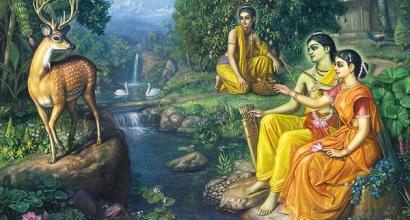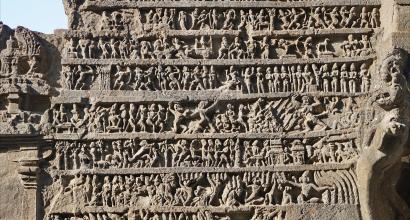We can gather quite a few biographical details about Viśākhadatta from the prastāvanā of his play Mudrārākṣasa; he was the grandson of Vaṭeśvara-datta and the son of Bhāskara-datta (or Pṛthu). However, it is quite difficult to ascertain who these men were and where they lived; it is also challenging to arrive at a fair estimate of the period in which they existed. The bharata-vākya of the play reads –
vārāhīm-ātmayonestanumavanavidhāvāsthitasyānurūpāṃ
yasya prāgdantakoṭiṃ pralaya-parigatā śiśriye bhūta-dhātrī|
mlecchairudvijyamānā bhuja-yugam-adhunā saṃśritā raja-mūrteḥ
sa śrīmad-bandhu-bhṛtyaściram-avatu mahīṃ pārthivaścandra-guptaḥ||
The scholar Wilson estimated that the play was composed in the twelfth century CE, presuming that the word mleccha in the verse above is a reference to Muhammad Ghori. However, K.T. Telang does not agree with his views and places the play at the beginning of the eighth century CE. Keith thinks that the play must have been composed in the ninth century CE or before. Sylvain Levi is of the view that the Mudrārākṣasa was written in the early years of the seventh century CE. However, Jayaswal and others opine that the play was composed during the reign of Candgraupta II; they base their view on the words adhunā and candraguptaḥ that appear as a part of the bharata-vākya. Though this is not indisputable, many scholars think that Jayaswal’s estimate is likely to be the closest to reality.
We may summarise the main arguments in favour of this argument below. From the references to Sugāṅga-prāsāda, Puṣpa-catvara, and gardens, we can infer that the playwright was quite familiar with the city of Pāṭalīputra. The city was reduced to nothing by the time of Hiuen Tsang’s (Xuanzang) visit to India, i.e., in the period between 629-645 CE. Therefore, Viśākhadatta must have existed before this period. In the times prior to this, three different kings by the name Candra-gupta ruled the city of Pāṭalīputra. Candra-gupta Maurya was the first one; after quite a few centuries, Candra-gupta I and Candra-gupta II made Pāṭalīputra their capital city. Among them, it is unlikely that the bharata-vākya refers to Candra-gupta Maurya, because, during his reign, the śakas hadn’t invaded the country (see verse 5.11). Candra-gupta I was not that famous as a king. The only remaining possibility is Candra-gupta II. Quite a few scholars do not agree that the king mentioned in the verse is Candra-gupta II. The reasons they cite are as follows – hūṇas (Huns) are said to have followed Malayaketu; the Huns hadn’t attacked India during the times of Candra-gupta II – so say some; however, we will have to keep in mind that though the hūṇas hadn’t infested the boundaries of India yet, their existence was not unknown to the Indians. The Lalita-vistara mentions hūṇa-lipi, i.e., the script of the Huns; the Mahābhārata (1.176.33-7) and Kālidāsa’s Raghuvaṃśa (6.68) mention them. The ‘mlecchas’ who were causing trouble back then could have been the śakas; the play Devī-candragupta tells us that Candra-gupta killed the lecherous king of the śakas, who had desired his elder brother Rāma-gupta’s wife. This establishes the context for the phrase bandhu-bhṛtyaḥ that occurs in the verse.
The words kalyāṇa-kula, deva, (4.4) and śrīmat that occur in the play seem to refer to Candra-gupta[1]; in the place of the word ‘candra-guptaḥ’, (daṃ)ranti-varmā and (a)vanti-varmā are found in some editions; these, however, are not the correct readings; we do not have any references to kings by these names. We know of two kings by the name Avanti-varmā – one ruled from Kashmir around 855-83 CE; the other was Harṣa’s in-law, the Maukhari ruler who ruled towards the end of the sixth century CE. It is also thought that the play belongs to his times. If we were to accept this argument, the counter-argument that the hūṇas hadn’t invaded India will hold true; however, the word candra-guptaḥ in the verse cannot simply change to vanti-varmā; it is likely that somebody wilfully changed it; moreover, this difference in reading is found only in one manuscript. Alfred Hillebrandt and others have found this reading to be superfluous and do not hold the particular manuscript in great regard. It is very likely that the original reading was candra-guptaḥ; it is possible that the team of artists who staged the play during the reign of the king Avanti-varmā tried to include his name in the verse of the bharata-vākya; therefore, they have included the word vanti-varmā in association with the word adhunā.
In the prastāvanā of the play, there is a reference to candra-grahaṇa, i.e., lunar eclipse (candra means the moon). Jacobi says that the particular eclipse took place on the 2nd December 860 CE and Dr. S Srikantha Sastri[2] estimates it to have occurred in either 388 or 397 CE. The two scholars say that the play was composed in that particular period. However, we cannot be sure if the play refers to an actual eclipse or makes its mention only figuratively. The play says that the eclipse actually did not take place. Can we come to a conclusion about the period of composition of the play merely through the reference to candra-grahaṇa?
The Mudrārākṣasa bears some semblance in some of its aspects to epic poems and plays such as the Raghuvaṃśa, Kirātārjunīya, Vakrokti-pañcāśikā, Śiśupālavadha, and Mṛcchakaṭika. However, this does not help us determine anything about the play because the period of composition of the aforementioned works has not been conclusively arrived at yet. It is difficult to say which one of these was composed first and which ones were imitations.
It is not right to use the stylistics of a language to establish the period of composition of any literary work. Still, we can say the following – the language of the Mudrārākṣasa is well-sculpted and exhibits high refinement; it is precise, concise, and lucid; its conciseness does not make it complex. In fact, complexity in construction is seen in poets starting from Bāṇa; neither Bhāsa nor Kālidāsa makes his language unnecessarily pedantic and convoluted; we hardly find a long or complex samāsa throughout the Śākuntala. Thus, it wouldn’t be too great an approximation if we were to say that Viśākhadatta lived around the times of Kālidāsa.
Among the various works authored by Viśākhadatta, we have been able to find only the Mudrārākṣasa in its entirety; we learn from Bhoja’s Śṛṅgāra-prakāśa that Viśākhadatta had also authored works called Rāghavānanda, Devī-candragupta, and Abhisārikā-vañcitaka. Among these, some parts of Devī-candragupta have been discovered; we hardly know anything about the rest of the plays.
To be continued ...
The current series of articles is an enlarged adaption of Prof. A. R. Krishnasastri's Kannada treatise Saṃskṛta-nāṭaka. They are presented along with additional information and footnotes by Arjun Bharadwaj.
[1] J.B.O.R.S., 1932, pages 37 onwards
[2] Karṇāṭaka-mudrārākṣasa-nāṭakam composed by Moṭagānahalli Rāmaśeṣa-śāstrī; see Foreword page 25; I.H.Q., VII, 168














































